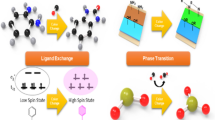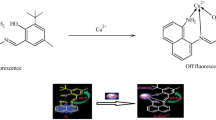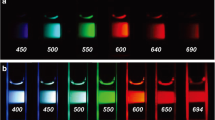Abstract
A colorimetric sensor with pyridyl and carbohydrazide components has been synthesized and visibly turns blue in the presence of Fe(II). The colorless sensor also changes color when exposed to Co(II) and Cu(II), but its color becomes yellow. The sensor shows no visible response to other metal ions such Ca2+, Cr3+, Mn2+, Fe3+, Ni2+, Zn2+, Cd2+, Ag+, Hg2+, and Pb2+. The binding ratio of the sensor to Fe(II), Co(II), and Cu(II) is 2 sensors to 1 metal ion. The binding constants of the sensor are: Fe(II): 1.0 × 109 M−2, Co(II): 2 × 109 M−2, and Cu(II): 3.0 × 109 M−2. The sensor works well at neutral pH and micromolar concentrations of Fe(II), Co(II), and Cu(II) can be detected in water samples. The sensor’s color response to Cu(II) is uniquely attenuated by glutathione.
Similar content being viewed by others
References
E. L. Que, D. W. Domaille and C. J. Chang, Metals in neurobiology: probing their chemistry and biology with molecular imaging, Chem. Rev., 2008, 108, 1517–1549.
D. W. Domaille, E. L. Que and C. J. Chang, Synthetic fluorescent sensors for studying the cell biology of metals, Nat. Chem. Biol., 2008, 4, 168–175.
K. L. Haas and K. J. Franz, Application of metal coordination chemistry to explore and manipulate cell biology, Chem. Rev., 2009, 109, 4921–4960.
Y. Ma, W. Luo, P. J. Quinn, Z. Liu and R. C. Hider, Design, synthesis, physicochemical properties, and evaluation of novel iron chelators with fluorescent sensor, J. Med. Chem., 2004, 47, 6349–6362.
E. Yavin, R. Kikkiri, S. Gil, R. Arad-Yellin, E. Yavin and A. Shanzer, Synthesis and biological evaluation of lipophilic iron chelators as protective agents from oxidative stress, Org. Biomol. Chem., 2005, 3, 2685–2687.
K. B. Kim, H. Kim, E. J. Song, S. Kim, I. Noh and C. Kim, A cap-type Schiff base acting as a fluorescence sensor for zinc(II) and a colorimetric sensor for iron(II), copper(II), and zinc(II) in aqueous media, Dalton Trans., 2013, 42, 16569–16577.
T. C. Fox, J. E. Shaff, M. A. Grusak, W. A. Norvell, Y. Chen, R. L. Chaney and L. V. Kochian, Direct measurement of 59Fe-labeled Fe2+ influx in roots of pea using a chelator buffer system to control free Fe2+ in solution, Plant Physiol., 1996, 111, 93–100.
S. Sen, S. Sarkar, B. Chattopadhyay, A. Moirangthem, A. Basu, K. Dhara and P. Chattopadhyay, A ratiometric fluorescent chemosensor for iron discrimination of Fe2+ and Fe3+ and living cell application, Analyst, 2012, 137, 3335–3342.
L. Long, N. Wang, Y. Han, M. Huang, X. Yuan, S. Cao, A. Gong and K. Wang, A coumarin-based fluorescent probe for monitoring labile ferrous iron in living systems, Analyst, 2918, 143, 2555–2562.
A. Farhi, F. Firdaus and M. Shakir, Design and application of a tripodal on-off type chemosensor for discriminative and selective detection of Fe2+ ions, New J. Chem., 2018, 42, 6161–6167.
C. Bhaumik, S. Das, D. Maity and S. Baitalik, A terpyridylimidazole (typ-HImzPh3) based bifunctional receptor for multichannel detection of Fe2+ and F− ions, Dalton Trans., 2011, 40, 11795–11808.
X. He, G.-B. Zhang, Z. X. Chi, P.-F. Dai, J.-Y. Huang and J.-X. Yang, Terpyridine functionalized α-cyanostilbene derivative as excellent fluorescence and naked eyes Fe2+ probe in aqueous environment, Chem. Pap., 2017, 71, 2209–2215.
Z.-B. Zheng, Z.-M. Duan, Y.-Y. Ma and K.-Z. Wang, Highly sensitive and selective difunctional ruthenium(II) complex-based chemosensor for dihydrogen phosphate anion and ferrous cation, Inorg. Chem., 2013, 52, 2306–2316.
J. M. Jung, S. Y. Lee and C. Kim, A novel colorimetric chemosensor for multiple target metal ions Fe2+, Co2+, and Cu2+ in a near-perfect aqueous solution: Experimental and theoretical studies, Sens. Actuators, B, 2017, 251, 291–301.
L. Q. Li and Z. H. Liu, A Colorimetric and Fluorescent Sensor for Iron Recognition Based on Rhodamine Derivative, J. Fluoresc., 2017, 27, 427–431.
S. R. Bhatta, V. Bheemireddy, G. Vijaykumar, S. Debnath and A. Thakur, An Efficient Molecular Tool with Ferrocene Backbone: Discriminating Fe3+ and Fe2+ in Aqueous Media, Organometallics, 2017, 36, 2141–2152.
C.-Y. Tsai and Y.-W. Lin, A highly selective and sensitive fluorescence assay for determination of copper(II) and cobalt(II) ions in environmental water and toner samples, Analyst, 2013, 138, 1232–1238.
C.-Y. Li, X.-B. Zhang, Z. Jin, R. Han, G.-L. Shen and R.-Q. Yu, A fluorescent chemosensor for cobalt ions based on a multi-substituted phenol-ruthenium(II) tris(bipyridine) complex, Anal. Chim. Acta, 2006, 580, 143–148.
D. Ou, L. Zhang, Y. Huang, X. Lou, J. Qin and Z. Li, A new disubstituted polyacetylene bearing 6-benzylaminopurine moieties: post functional synthetic strategy and sensitive chemosensor towards copper and cobalt ions, Macromol. Rapid Commun., 2013, 34, 759–766.
J. H. Ye, L. J. Duan and L. L. Jin, A fluorescence sensor for Cu2+ and Co2+ based on click-generated triazole moiety, Adv. Mater. Res., 2012, 554–556, 2045–2048.
J. Shi, C. Lu, D. Yan and L. Ma, High selectivity sensing of cobalt in HepG2 cells based on necklace model microenvironment-modulated carbon dot-improved chemiluminescence in Fenton-like system, Biosens. Bioelectron., 2013, 5, 58–64.
H.-Y. Luo, X.-B. Zhang, C.-L. He, G.-L. Shen and R.-Q. Yu, Synthesis of dipicolylamino substituted quinazoline as chemosensor for cobalt(II) recognition based on excitedstate intramolecular proton transfer, Spectrochim. Acta, Part A, 2008, 70, 337–342.
Y. Yao, D. Tian and H. Li, Cooperative binding of bifunctionalized and click-synthesized silver nanoparticles for colorimetric Co2+ sensing, ACS Appl. Mater. Interfaces, 2010, 2, 684–690.
H. Wang, J. Li, D. Yao, Q. Gao, F. Guo and P. Xie, A highly selective colorimetric sensor to Fe3+ and Co2+ in aqueous solutions, Res. Chem. Intermed., 2013, 39, 2723–2734.
K. Liu, P. Guo, L. Liu and X. Shi, Fluorescence enhancement of a novel pyrazine coupled rhodamine derivative for the paramagnetic Co2+ detection, Sens. Actuators, B, 2017, 250, 667–672.
H.-B. Liu, H.-Y. Zhao, Z. Tong, Y. Zhang, B. Lan and J. Wang, A colorimetric, ratiometric, and fluorescent cobalt(II) chemosensor based on mixed organic ligands, Sens. Actuators, B, 2017, 239, 511–514.
P. G. Mahajan, N. C. Dige, N. K. Desai, S. R. Patil, V. V. Kondalkar, S.-K. Hong and K. H. Lee, Selective detection of Co2+ by fluorescent nano probe: Diagnostic approach for analysis of environmental samples and biological activities, Spectrochim. Acta, Part A, 2018, 198, 136–144.
L. Wang, X. Gong, Q. Bing and G. Wang, A new oxadiazolebased dual-mode chemosensor: Colorimetric detection of Co2+ and fluorometric detection of Cu2+ with high selectivity and sensitivity, Microchem. J., 2018, 142, 279–287.
M. Sohrabi, M. Amimasr, S. Meghdadi, M. Lutz, M. B. Torbati and H. Farrokhpour, A highly selective fluorescence turn-on chemosensor for Zn2+, and its application in liver cell imaging, and as a colorimetric sensor for Co2+: experimental and TD-DFT calculations, New J. Chem., 2018, 42, 12595–12606.
J. F. Zhang, Y. Zhou, J. Yoon, Y. Kim, S. J. Kim and J. S. Kim, Naphthalimide modified rhodamine derivative: ratiometric and selective fluorescent sensor for Cu2+ based on two different approaches, Org. Lett., 2010, 12, 3852–3855.
X. Qi, E. J. Jun, L. Xu, S.-J. Kim, J. S. J. Hong, Y. J. Yoon and J. Yoon, New BODIPY derivatives as OFF–ON fluorescent chemosensor and fluorescent chemodosimeter for Cu2+: cooperative selectivity enhancement toward Cu2+, J. Org. Chem., 2006, 71, 2881–2884.
Y. R. Bhorge, H.-T. Tsai, K.-F. Huang, A. J. Pape, S. N. Janaki and Y.-P. Yen, A new pyrene-based Schiff-base: a selective colorimetric and fluorescent chemosensor for detection of Cu(II) and Fe(III), Spectrochim. Acta, Part A, 2014, 130, 7–12.
J. Huang, Y. Xu and X. Qian, A colorimetric sensor for Cu2+ in aqueous solution based on metal ion-induced deprotonation: deprotonation/protonation mediated by Cu2+–ligand interactions, Dalton Trans., 2009, 71, 1761–1766.
Y.-W. Liu, J.-L. Chir, S.-T. Wang and A.-T. Wu, A selective colorimetric sensor for Cu2+ in aqueous solution, Inorg. Chem. Commun., 2014, 45, 112–115.
E. Gaggelli, H. Kozlowski, D. Valensin and G. Valensin, Copper homeostasis and neurodegenerative disorders (Alzheimer’s, prion, and Parkinson’s diseases and amyotrophic lateral sclerosis), Chem. Rev., 2006, 106, 1995–2044.
F. Arnesano, L. Banci, I. Bertini and S. Ciofi-Baffoni, Perspectives in inorganic structural genomics: a trafficking route for copper, Eur. J. Inorg. Chem., 2004, 2004, 1583–1593.
G. J. Park, I. H. Hwang, E. J. Song, H. Kim and C. Kim, A colorimetric and fluorescent sensor for sequential detection of copper ion and cyanide, Tetrahedron, 2014, 70, 2822–2828.
K. J. Barnham, C. L. Masters and A. I. Bush, Neurodegenerative diseases and oxidative stress, Nat. Rev. Drug Discovery, 2004, 3, 205–214.
G. R. You, G. J. Park, J. J. Lee and C. Kim, A colorimetric sensor for the sequential detection of Cu2+ and CN− in fully aqueous media: practical performance of Cu2+, Dalton Trans., 2015, 44, 9120–9129.
Y. K. Jang, U. C. Nam, H. L. Kwon, I. H. Hwang and C. Kim, A selective colorimetric and fluorescent chemosensor based-on naphthol for detection of Al3+ and Cu2+, Dyes Pigm., 2013, 99, 6–13.
R. Krämer, Fluorescent chemosensors for Cu2+ ions: fast, selective, and highly sensitive, Angew. Chem., Int. Ed., 1998, 37, 772–773.
J. Y. Noh, G. J. Park, Y. J. Na, H. Y. Jo, S. A. Lee and C. Kim, A colorimetric “naked-eye” Cu(II) chemosensor and pH indicator in 100% aqueous solution, Dalton Trans., 2014, 43, 5652–5656.
A. J. Beneto and A. Siva, A phenanthroimidazole based effective colorimetric chemosensor for copper(II) and fluoride ions, Sens. Actuators, B, 2017, 247, 526–531.
L. Li, H. Li, G. Liu and S. Pu, A colorimetric and fluorescent chemosensor for selective detection of Cu2+ based on a new diarylethene with a benzophenone hydrazone unit, Luminescence, 2017, 32, 1473–1481.
C. Wu, J. Wang, J. Shen, C. Zhang, Z. Wu and H. Zhou, A colorimetric quinolone-based chemosensor for sequential detection of copper ion and cyanide anions, Tetrahedron, 2017, 73, 5715–5719.
A. K. Manna, J. Mondal, K. Rout and G. K. Patra, A new ICT based Schiff-base chemosensor for colorimetric selective detection of copper and its copper complex for both colorimetric and fluorometric detection of Cysteine, J. Photochem. Photobiol., A, 2018, 367, 74–82.
P. Milindanuth and P. Pisitsak, A novel colorimetric sensor based on rhodamine-B derivative and bacterial cellulose for the detection of Cu(II) ions in water, Mater. Chem. Phys., 2018, 216, 325–331.
R. Chandera, An. Ghorai and G. K. Patra, A simple benzildihydrazone derived colorimetric and fluorescent ‘on-off-on’ sensor for sequential detection of copper(II) and cyanide ions in aqueous solution, Sens. Actuators, B, 2018, 255, 701–711.
G. J. Park, Y. J. Na, H. Y. Jo, S. A. Lee and C. Kim, A colorimetric organic chemo-sensor for Co2+ in a fully aqueous environment, Dalton Trans., 2014, 43, 6618–6622.
M. Iniya, D. Jeyanthi, K. Krishnaveni and D. Chellappa, Vitamin B6 cofactor based fluorescent probe for sensing an anion F− and cation Co2+ independently in a pure aqueous medium, RSC Adv., 2014, 4, 25393–25397.
D. Maity and T. Govindaraju, Highly selective colorimetric chemosensor for Co2+, Inorg. Chem., 2011, 50, 11282–11284.
J.-R. Zhou, D.-P. Liu, Y. He, X.-J. Kong, Z.-M. Zhang, Y.-P. Ren, L.-S. Long, R.-B. Huang and L.-S. Zheng, A highly selective colorimetric chemosensor for cobalt(II) ions based on a tripodal amide ligand, Dalton Trans., 2014, 43, 11579–11586.
Y. Li, J. Wu, X. Jin, J. Wang, S. Han, W. Wu, J. Xu, W. Liu, X. Yao and Y. Tang, A bimodal multianalyte simple molecule chemosensor for Mg2+, Zn2+, and Co2+, Dalton Trans., 2014, 43, 1881–1887.
M. N. El-Nahass, D. M. A. El-Aziz and T. A. Fayed, Selective “on–off–on” switchable hemosensor for metal ions detection and its complexes, Sens. Actuators, B, 2014, 205, 377–390.
F. A. Abebe, C. S. Eribal, G. Ramakrishna and E. Sinn, A “turn-on” fluorescent sensor for the selective detection of cobalt and nickel ions in aqueous media, Tetrahedron Lett., 2011, 52, 5554–5558.
S. H. Mashraqui, M. Chandiramani, R. Betkar and K. Poonia, A simple internal charge transfer probe offering dual optical detection of Co(II) via color and fluorescence modulations, Tetrahedron Lett., 2010, 51, 1306–1308.
S. Patil, U. Fegade, S. K. Sahoo, A. Singh, J. Marek, N. Singh and R. Bendre, Highly sensitive ratiometric chemosensor for selective “naked-eye” nanomolar detection of Co2+ in semi-aqueous media, ChemPhysChem, 2014, 15, 2230–2235.
S. Goswami, D. Sen and N. K. Das, A new highly selective, ratiometric and colorimetric fluorescence sensor for Cu2+ with a remarkable red shift in absorption and emission spectra based on internal charge transfer, Org. Lett., 2010, 12, 856–859.
T. G. Jo, Y. J. Na, J. J. Lee, M. M. Lee, S. Y. Lee and C. Kim, A multifunctional colorimetric chemosensor for cyanide and copper(II) ions, Sens. Actuators, B, 2015, 211, 498–506.
S. A. Lee, J. J. Lee, J. W. Shin, K. S. Min and C. Kim, A colorimetric chemosensor for the sequential detection of copper(II) and cysteine, Dyes Pigm., 2015, 116, 131–138.
R. Joseph, J. P. Chinta and C. P. Rao, Calix[4]arene-based 1,3-diconjugate of salicylylimine having dibenzyl amine moiety (L): synthesis, characterization, receptor properties toward Fe2+, Cu2+, and Zn2+, crystal structures of its Zn2+ and Cu2+ complexes, and selective phosphate sensing, Inorg. Chem., 2011, 50, 7050–7058.
H. M. Yeo, B. J. Ryu and K. C. Nam, A novel fluoride ion colorimetric chemosensor, Org. Lett., 2008, 10, 2931–2934.
Y. J. Na, Y. W. Choi, J. Y. Yun, K.-M. Park, P.-S. Chang and C. Kim, Dual-channel detection of Cu2+ and F− with a simple Schiff-based colorimetric and fluorescent sensor, Spectrochim. Acta, Part A, 2014, 136, 1649–1657.
E. J. Song, J. Kang, G. R. You, G. J. Park, Y. Kim, S.-J. Kim, C. Kim and R. G. Harrison, A single molecule that acts as a fluorescence sensor for zinc and cadmium and a colorimetric sensor for cobalt, Dalton Trans., 2013, 42, 15514–15520.
N. O. Laschuk, I. I. Ebralidze, S. Quaranta, S. T. W. Kerr, J. G. Egan, S. Gillis, F. Gaspari, A. Latini and O. V. Zenkina, Rational design of a material for rapid colorimetric Fe2+ detection, Mater. Des., 2016, 107, 18–25.
X. Bai, Y. Li, H. Gu and Z. Hua, Selective colorimetric sensing of Co2+ and Cu2+ using 1-(2-pyridylazo)-2-naphthol derivative immobilized polyvinyl alcohol microspheres, RSC Adv., 2015, 5, 77217–77226.
A. Garcia de Torres, J. M. Cano Pavon and F. Castaneda, Analytical properties of di(2-pyridyl) ketone 2-furoylhydrazone and spectrophotometric determination of trace amounts of iron, Mikrochim. Acta, 1984, 3, 375–382.
M. J. Frisch, G. W. Trucks, H. B. Schlegel, G. E. Scuseria, M. A. Robb, J. R. Cheeseman, G. Scalmani, V. Barone, G. A. Petersson, H. Nakatsuji, X. Li, M. Caricato, A. Marenich, J. Bloino, B. G. Janesko, R. Gomperts, B. Mennucci, H. P. Hratchian and J. V. Ort, Gaussian 09, Revision A.02 (n.d.).
A. D. Becke, Density-functional thermochemistry. III. The role of exact exchange, J. Chem. Phys., 1993, 98, 5648–5652.
C. Lee, W. Yang and R. G. Parr, Development of the Colle-Salvetti correlation-energy formula into a functional of the electron density, Phys. Rev. B: Condens. Matter Mater. Phys., 1988, 37, 785–789.
M. M. Francl, W. J. Pietro, W. J. Hehre, J. S. Binkley, M. S. Gordon, D. J. DeFrees and J. A. Pople, Self-consistent molecular orbital methods. 23. a polarization-type basis set for 2nd-row elements, J. Chem. Phys., 1982, 77, 3654–3665.
P. J. Hay and W. R. Wadt, Ab initio effective core potentials for molecular calculations. Potentials for the transition metal atoms Sc to Hg, J. Chem. Phys., 1985, 82, 270–283.
M. Cossi and V. Barone, Time-dependent density functional theory for molecules in liquid solutions, J. Chem. Phys., 2001, 115, 4708–4471.
E. M. Kober and T. J. Meyer, Concerning the absorption spectra of the ions M(bpy)3 2+ (M=Fe, Re, Os: bpy=2,2′-bipyridine), Inorg. Chem., 1982, 21, 3967–3977.
E. Requena, J. J. Laserna, A. Navas and F. G. Sanchez, Pyridine-2-aldehyde 2-Furoylhydrazone as a Fluorogenic Reagent for the Determination of Nanogram Amounts of Gallium, Analyst, 1983, 108, 933–938.
S. Huang, P. Du, C. Min, Y. Liao, H. Sun and Y. Jiang, Poly(1-amino-5-chloroanthraquinone): highly selective and ultrasensitive fluorescent chemosensor for ferric ion, J. Fluoresc., 2013, 23, 621–627.
H. G. Gorchev and G. Ozolins, WHO guidelines for drinking-water quality, WHO Chron., 2011, 38, 104–108.
W. S. Postal, E. J. Vogel, C. M. Young and F. T. Greenaway, The binding of copper(II) and zinc(II) to oxidized glutathione, J. Inorg. Biochem., 1985, 25, 25–33.
Author information
Authors and Affiliations
Corresponding author
Additional information
Electronic supplementary information (ESI) available: UV-vis spectra of the sensor and metals with the sensor; Job plots of Fe(II), Co(II), and Cu(II) with the sensor; absorption spectra of the sensor and Cu(II); an absorption plot of the sensor with Cu(II) and other metal ions; calculated excitation energies and orbital diagrams; and reusable plots of Fe(II) and Co(II). See DOI: 10.1039/c8pp00545a
Rights and permissions
About this article
Cite this article
Yang, M., Chae, J.B., Kim, C. et al. A visible chemosensor based on carbohydrazide for Fe(II), Co(II) and Cu(II) in aqueous solution. Photochem Photobiol Sci 18, 1249–1258 (2019). https://doi.org/10.1039/c8pp00545a
Received:
Accepted:
Published:
Issue Date:
DOI: https://doi.org/10.1039/c8pp00545a




